This inspiring case study was created by MELEWI, a traveling product, UX, and UI design studio, working with passionate people and businesses globally.
Read our fresh post on better brainstorming techniques for remote teams.
From helping deliver McDonald’s meals across 4 continents, to creating a way for the unbanked takeout microloans in India, to helping Samsung on their mission to elevate digital art in Asia, they’ve designed products for users and markets around the world.
Related read: we recommend you check our recent guide to the future of teamwork and team collaboration.
MELEWI works remotely and travels to be inspired, gain perspective, and build products and businesses that speak to everyone, everywhere.
- Website: melewi.net
- Twitter: twitter.com/melewi
- Facebook: facebook.com/hellomelewi
- Instagram: instagram.com/hellomelewi
Yes, we work remotely
Whenever someone hears that we’re a remote team, a question we always get asked is “Wow, that must be tough; how do you guys work together?”
It’s a fun question to answer — because with a fully distributed team of 7 people and clients in over 35 countries, we’ve spent the last 5 years at our product UX UI design studio Melewi refining how to work effectively together while being apart.
Working remotely simply means we’re not in the same room (or even country) and when it comes to effective teamwork, physical proximity isn’t the factor that “makes or breaks it”.
We’ve found that the trick to remote collaboration isn’t about making it work despite being on separate continents, it’s about realizing what’s useful about working in the same room and finding ways to replicate that online.
Whether it’s running user-testing sprints with startups around the world, writing case studies for publications, or designing apps for companies like Visa and McDonald’s, brainstorming and creating remotely is a way of life for us — and one that we thoroughly enjoy.
3 vital ingredients of remote brainstorming
After years of experimentation, we’ve found 3 vital ingredients to brainstorm in remote teams successfully:
1. Reframe the video call mindset
What we’re used to
When you imagine being in a video call, it’s a (relatively and hopefully) quick 30-minute Skype meeting, in which a conversation happens between a couple of people. As with a real-life chat, there’s typically at least one person talking at any given moment. Any lull in conversation feels awkward, and someone will eventually jump in to say something.
In contrast, a bunch of people in a room thinking and working with the occasional silence seems perfectly normal.
So how do we make this work remotely?
Video calls are vital to any remote team, and they’re perfect for brainstorming sessions. At Melewi, we’ve named these sessions ‘mini-sprints’ in order to differentiate them from our regular meetings.
Simply renaming these sessions reframes everyone’s mindset and the team treats these video calls as a space for them to put their heads together, instead of a meeting, where the occasional silence is not the norm.
Successful brainstorming as a location-independent team starts with creating the right environment and cultivating the right mindset to approach remote collaboration.
Try doing this:
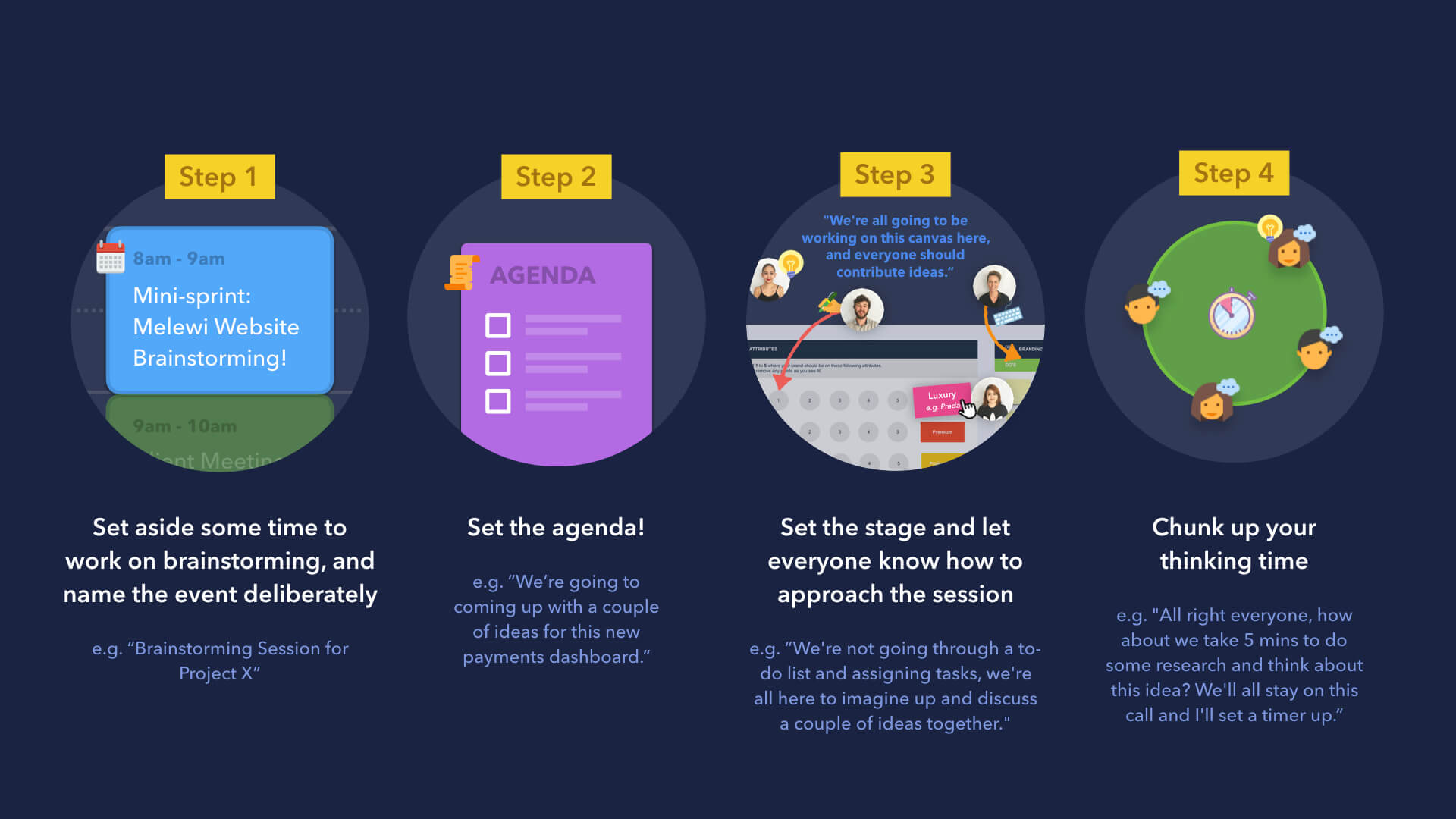
- Step 1. Set aside an hour to two to work on brainstorming, name this event accordingly e.g. Brainstorming Session for Project X
- Step 2. Set the agenda e.g. “We’re going come up with some ideas for this new payments dashboard”
- Step 3. Set the stage and let everyone know how to approach the session e.g. “We’re all going to be working on this canvas here, and everyone should contribute ideas. Remember we’re not going through a to-do list and assigning tasks, we’re all here to imagine up and discuss a couple of ideas together.”
- Step 4. Chunk up your thinking time e.g. “Alright everyone, shall we take 5 mins to do some research and think about this idea? We’ll stay on this call and I’ll set a timer “
Tip: Sometimes, team members aren’t used to working together in silence on a call and feel the need to either a) delegate tasks and get off the call, or b) fill the silence. That’s perfectly normal, and it’s best to address it when it happens to reset the expectations for the brainstorming call.
2. Find a central project hub
What we’re used to
You might be used to having a whiteboard, pen, paper and your teammates in the same physical space. In this respect, it’s easy to have a central location to park your ideas, for instance, the whiteboard in meeting room A.
When the hub of your project is typically located in the office, it might be hard to imagine how to work with your team without being seated close by.
So how do we make this work remotely?
Having a central hub online for your project makes all the difference in the world. At Melewi, we’re a big fan of using online whiteboards.
After trying multiple tools, we’ve found that Realtimeboard allowed us to brainstorm and collaborate effectively. The tool lets us create and edit post-its, text boxes just like we would on a whiteboard. Realtimeboard also allows us to produce sketches, wireframes, as well as import different kinds of media.

More importantly, the tool supports online collaboration and has useful functions that allow the team to conduct video calls, create comments and conduct screenshares.
Try doing this:
With your team, take stock of the types of notes or materials you need in your brainstorming sessions. Once you have that, you can start searching for a tool that might fit best.
When you’ve found the suitable tool, try to keep all related materials there, including notes, content, and links to other tools you’re using.The board or canvas should be your go-to place for everything related to the project.
Try out multiple tools like Realtimeboard and stick to the one that best suits your team!
Here are a few tools we’ve tried:

Tip: It’s easy to feel like the tool isn’t working too well when it gets messy and confusing, especially if you have multiple people working on it. So make sure you keep the board organized and tidy it up every month!
3. Replicate real-life interaction
What we’re used to
In a typical office space, communication just happens — it’s much easier to have a spontaneous discussion when your team members are physically next to you. By contrast, the notion of location-independent work brings to mind images of miscommunication and endless frustration.
When you’re working in a different geographical location from your teammates, it’s a much farther distance to reach over and tap them on the shoulder. The thought of using only words, without a sketchbook in hand, to articulate your ideas can be daunting.
Due to the lack of physical proximity, it can be easy for things to be forgotten, for deadlines to slip, and for teammates to start working in silos.
So how do we make this work remotely?
The challenges below are not particularly challenging problems to solve, just things we take for granted when working together in real life.
Based on our experience, there are 3 challenges that could potentially crop up:
- You feel limited in expressing your ideas or thoughts — this is where communication breaks down because it feels too difficult;
- You feel confused and you don’t know what’s going on — this is where things feel disorganized and difficult to manage and you don’t know what is the way forward;
- You feel disconnected and alone — this is where you feel start to feel distant, and you don’t feel like you are part of the team.
These challenges aren’t particularly difficult to solve. At Melewi, we rectify them by scheduling check-in points, having frequent video calls and screen sharing, and using online sketches.
Try doing this:
1. Deliberately schedule check-in points
Set up recurring catch-ups to go over progress made on projects.
These don’t have to be a huge timesink! A general rule of thumb here at Melewi is to do either 15 mins daily, 30 mins weekly, or 1 hour fortnightly.
We also recommend never finishing a call or assigning tasks without setting up the next milestone or meeting. It is important to agree upon what tasks each individual has to complete before the next catch-up.
2. Video call + screen sharing should be your new normal
Video calls are paramount to our daily lives when working remotely! Being able to talk to someone face-to-face (or screen-to-screen) or see what they’re working on on their screen makes a big difference. A rule in the team is for the camera and audio to be switched on, and for screensharing to be used liberally.
Collaboration requires good communication, and a vital part of communication is non-verbal. In order to feel like you’re effectively communicating, you need to see how your teammates are reacting to what you’re saying, and you need to be able to view what they’re viewing.
We typically set our screens up to be able to see multiple things at once:
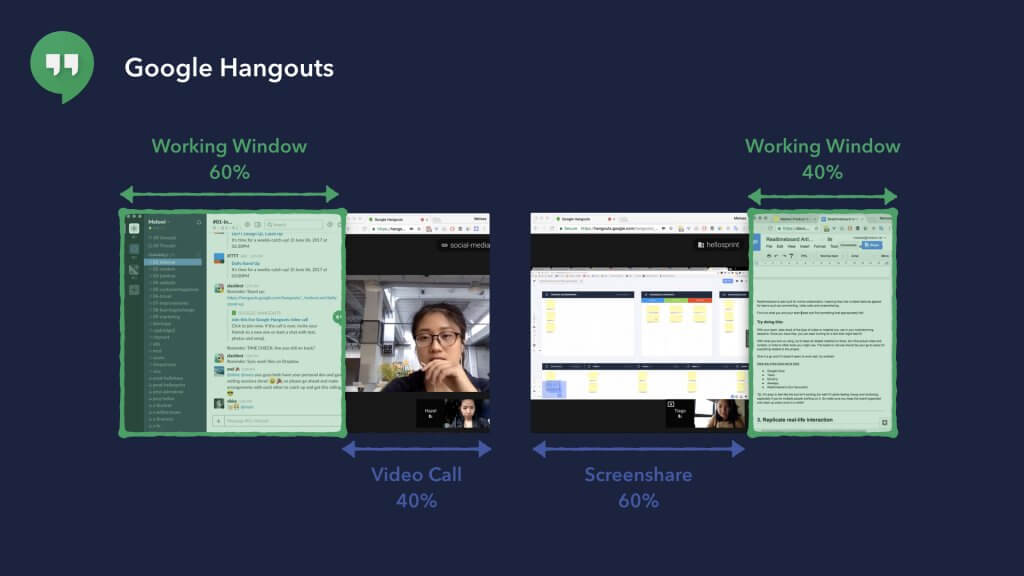
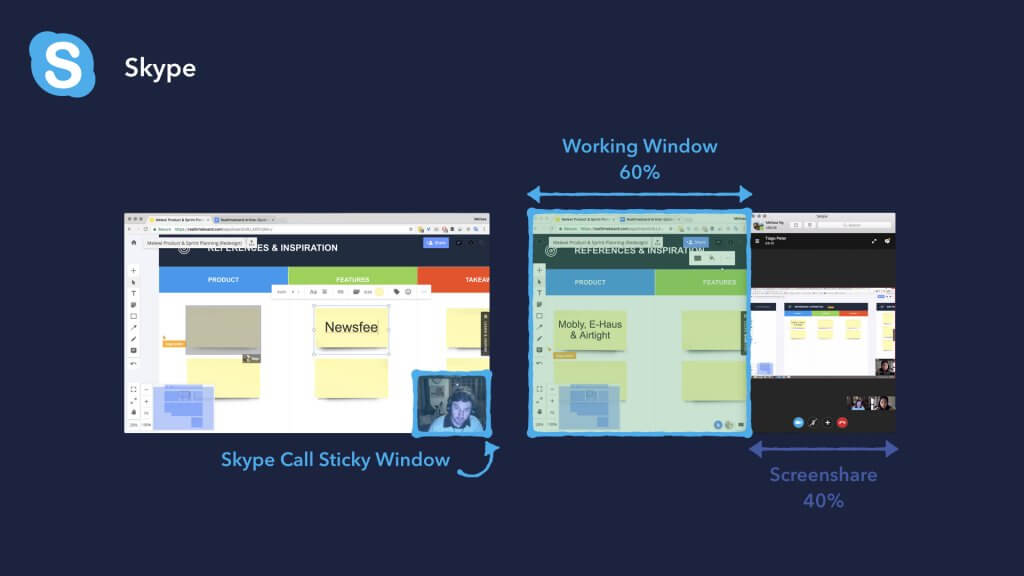
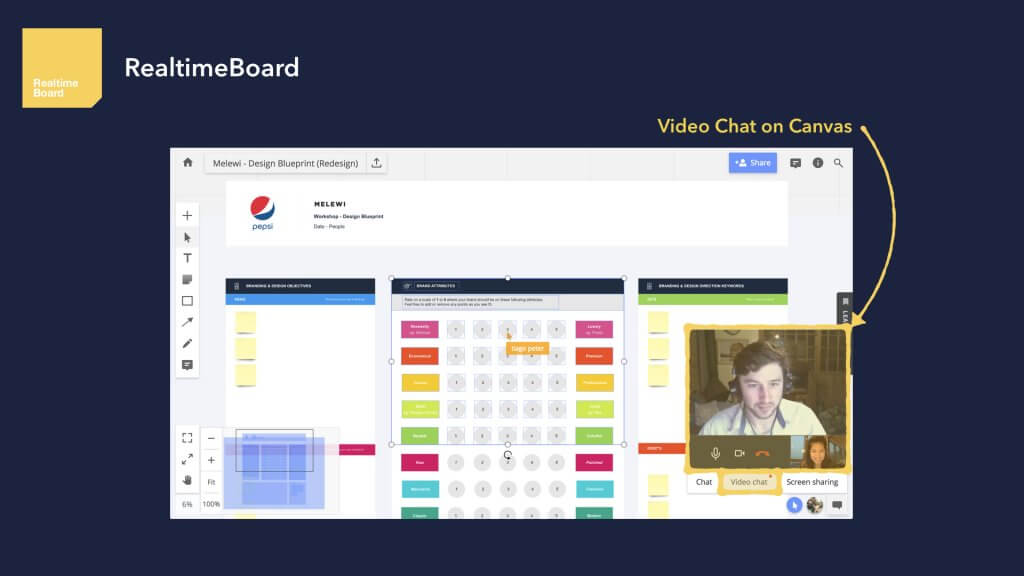
- Hangouts: split screen, screen sharing
- Skype: share screen + camera box
- Realtimeboard: video chat, cursor view
3. Use more than just words (sketching & using a tablet)
Sometimes you need more than just words! A simple tablet and a tool with a sketching feature allow you to illustrate your point easily.
You should never feel like effective communication between you and your team is hindered by the distance. Sharing sketches makes brainstorming not only more productive but also a lot more fun.
Conclusion
Brainstorming remotely can be awesome fun and awesomely effective. With the right mindset and tactics, great collaboration can happen anywhere — as long as there’s wifi and some kick-ass people to work with!
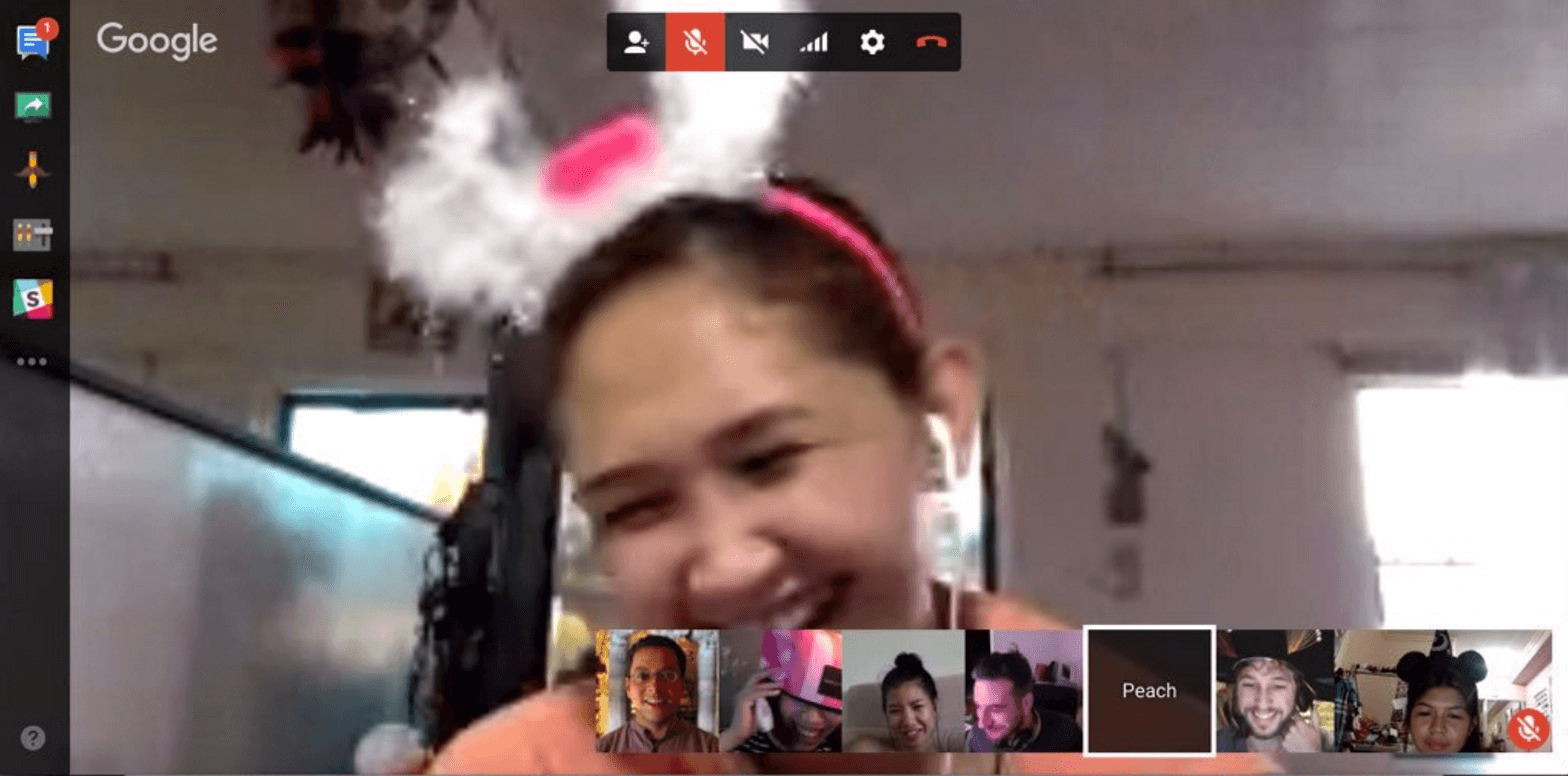
Lots of work but also lots of silly fun times during our daily standup!




